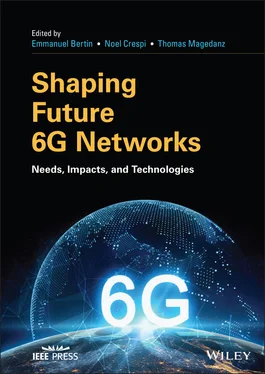Shaping Future 6G Networks
Здесь есть возможность читать онлайн «Shaping Future 6G Networks» — ознакомительный отрывок электронной книги совершенно бесплатно, а после прочтения отрывка купить полную версию. В некоторых случаях можно слушать аудио, скачать через торрент в формате fb2 и присутствует краткое содержание. Жанр: unrecognised, на английском языке. Описание произведения, (предисловие) а так же отзывы посетителей доступны на портале библиотеки ЛибКат.
- Название:Shaping Future 6G Networks
- Автор:
- Жанр:
- Год:неизвестен
- ISBN:нет данных
- Рейтинг книги:3 / 5. Голосов: 1
-
Избранное:Добавить в избранное
- Отзывы:
-
Ваша оценка:
- 60
- 1
- 2
- 3
- 4
- 5
Shaping Future 6G Networks: краткое содержание, описание и аннотация
Предлагаем к чтению аннотацию, описание, краткое содержание или предисловие (зависит от того, что написал сам автор книги «Shaping Future 6G Networks»). Если вы не нашли необходимую информацию о книге — напишите в комментариях, мы постараемся отыскать её.
Discover the societal and technology drivers contributing to build the next generation of wireless telecommunication networks Shaping Future 6G Networks: Needs, Impacts, and Technologies
Shaping Future 6G Networks
Shaping Future 6G Networks — читать онлайн ознакомительный отрывок
Ниже представлен текст книги, разбитый по страницам. Система сохранения места последней прочитанной страницы, позволяет с удобством читать онлайн бесплатно книгу «Shaping Future 6G Networks», без необходимости каждый раз заново искать на чём Вы остановились. Поставьте закладку, и сможете в любой момент перейти на страницу, на которой закончили чтение.
Интервал:
Закладка:
2 2A direct comparison between the transport and information communication technology (ICT) carbon emissions can be found in the report “A quick guide to your digital carbon footprint.” [Online] Available: https://www.ericsson.com/en/reports‐and‐papers/industrylab/reports/a‐quick‐guide‐to‐your‐digital‐carbon‐footprint
3 6G: The Path Toward Standardization
Guy Redmill1 and Emmanuel Bertin2
1Redmill Communications Ltd, London, UK
2Orange Innovation, France
3.1 Introduction
Historically, standardization has been fundamental to the success of each new generation – or “G” – of mobile network technology. It is the process through which we arrive at a set – or sets – of replicable guidelines governing technology, interoperability, and performance for a specific technology that realizes specific technical goals and that enables commercial delivery and operation, from a diverse community of providers.
This success is clear. There are now more than 5 billion mobile people using different generations of network technology, while the industry contributed more than $4 trillion to the global economy in 2019 [1]. In addition, millions more devices are connected via these networks, serving a wide range of Internet of Things (IoT) and machine‐to‐machine (M2M) applications.
For recent “Gs,” a broadly similar process has been followed, which has resulted in the release of standards, which can be adopted and followed by industry stakeholders. These standards provide templates that enable participants to contribute and to develop the solutions required to build a new network.
However, there are a number of factors that suggest the path to 6G may diverge from the most recent path taken to the delivery of a global standard. First, there are historic precedents that highlight alternative paths to realizing the common goal of a particular generation of mobile technology.
Second, regardless of the ultimate realization of 6G, the stakeholder ecosystem has changed dramatically as the mobile landscape has evolved. The traditional mobile value chain has expanded to include new classes of operators, new vendor consortia, as well as new spectrum holders (with license conditions that may differ from the previous model of country‐wide coverage obligations), and has attracted a wide range of new vertical actors, largely drawn by the new capabilities 5G can unlock. 6G will likely lead to further expansion of this ecosystem.
Third, new political pressures and fault lines have emerged, which have already affected the standardization work of the 3rd Generation Partnership Project, commonly known as 3GPP. Fourth, while a broad community of solution providers has been envisaged, in practice, this has narrowed dramatically, leaving many operators dependent on just a handful of suppliers. Efforts are underway to change this, which could lead to deviation from the current standards path – accelerating or impeding progress toward 6G. Finally, 5G is enabled by an entirely new operating model that, in turn, could change the way in which stakeholders interact to define new standards in the future.
This chapter explores the evolving landscape and considers possible future standardization models for 6G – and beyond – based on interviews with selected stakeholders and lessons drawn from the evolution of mobile network technology to date.
3.2 Standardization: A Long‐Term View
How did we reach the point at which 5G could be realized, via what is effectively a single body that represents global mobile standards, and which has become the preeminent voice in the industry? Historically, this was not the case for each previous generation of mobile technology.
There have been a number of successful standardization initiatives that have resulted in the release of each new generation of mobile technology – 2G, 3G, 4G, and, more recently, 5G. However, there has often been debate about how each such generation should be realized, which has led to variation in the implementation of some previous “Gs” and the emergence of parallel standards that have aimed to deliver the same outcome. In this section, we will briefly review current activities and explore previous approaches.
For a number of years, each new “G” has begun with the release of what is known as an “International Mobile Telecommunications” (IMT) recommendation. IMTs are defined by the International Telecommunications Union (ITU), a specialist agency of the United Nations. It is important to note that an IMT is simply a recommendation. It does not define how it should be realized, but it does define expected performance levels:
The term International Mobile Telecommunications (IMT) is the generic term used by the ITU community to designate broadband mobile systems. It encompasses IMT‐2000, IMT‐Advanced and IMT‐2020 collectively, [2].
At the ITU, work is already underway toward 6G under the overall banner of IMT‐2030. Stakeholders such as solution vendors, operators, research institutions, and other agencies are collaborating to define 6G and what it may mean in practice. As part of these activities, FG‐30 (Focus Group on Technologies for Network 2030) is creating a definition of what a 6G network should deliver:
The Focus Group intends to study the capabilities of networks for the year 2030 and beyond, when it is expected to support novel forward‐looking scenarios…The study aims to answer specific questions on what kinds of network architecture and the enabling mechanisms suitable for such novel scenarios [3].
This will eventually result in a new IMT requirements definition, which will be available for the industry.
3.3 IMTs Have Driven Multiple Approaches to Previous Mobile Generations
Previous generations of mobile technology have also been kick‐started by the agreement of a relevant IMT. While IMT‐2020 led to 5G and an agreed, unified approach spearheaded by the 3GPP, earlier IMTs have given rise to different approaches to achieve the same desired outcomes.
For example, IMT‐Advanced provided requirements for the 4th generation of mobile technology (4G), but there were several approaches that could have met these. Long‐term evolution – otherwise known as “LTE” – was just one example; Mobile WiMAX and Ultra Mobile Broadband, among others, were, for several years, considered as viable alternatives, although only two remained as candidate systems – LTE and Mobile WiMAX [4]. Similarly, the earlier IMT‐2000 recommendations, which gave rise to 3G, also generated several different candidate solutions, some of which saw commercial operation.
3GPP was originally founded in 1998, with the aim of bringing together a number of foundational partners to collaborate on common standards to meet the requirements of IMT‐2000 and the realization of what became known as 3G [5]. 3GPP based its efforts on the evolution of the existing GSM (the Global System for Mobile Communications) standards for 2G, originally driven through the European Telecommunications Standards Institute, or ETSI. The partnership agreement brought together organizations that had previously, either individually or via different collaboration groups, contributed to earlier generations of mobile technology.
3GPP’s efforts resulted in a set of standards for 3G – the Universal Mobile Telecommunications System (UMTS) – whose work has ultimately led to today’s 5G. However, a parallel organization (3GPP2) shadowed the work of the original 3GPP during this period, considering the perspectives of a different group of stakeholders, some of which proposed alternative candidates for 3G, such as CDMA2000, to meet the same IMT‐2000 requirements.
Читать дальшеИнтервал:
Закладка:
Похожие книги на «Shaping Future 6G Networks»
Представляем Вашему вниманию похожие книги на «Shaping Future 6G Networks» списком для выбора. Мы отобрали схожую по названию и смыслу литературу в надежде предоставить читателям больше вариантов отыскать новые, интересные, ещё непрочитанные произведения.
Обсуждение, отзывы о книге «Shaping Future 6G Networks» и просто собственные мнения читателей. Оставьте ваши комментарии, напишите, что Вы думаете о произведении, его смысле или главных героях. Укажите что конкретно понравилось, а что нет, и почему Вы так считаете.












